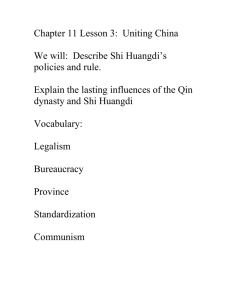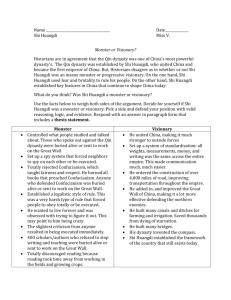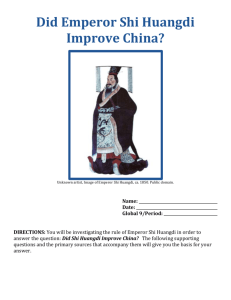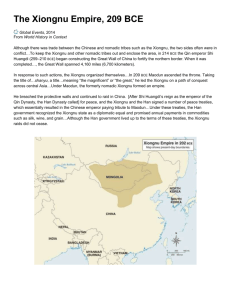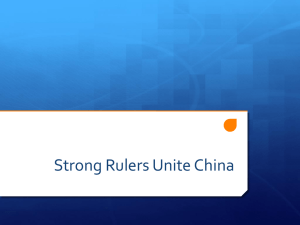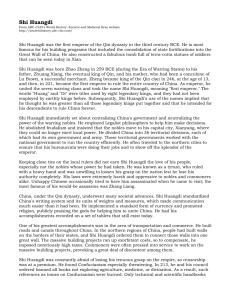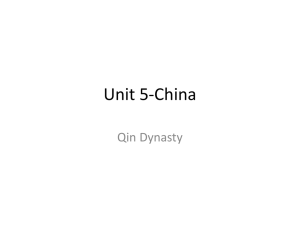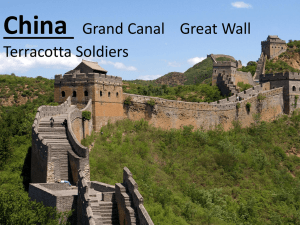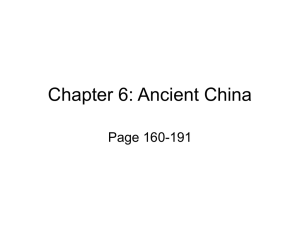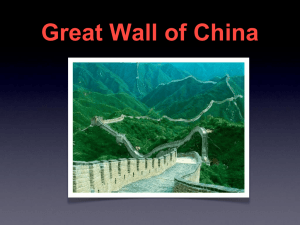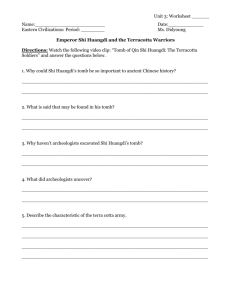The Emperor`s Clay Army How did Shi Huangdi build an empire in
advertisement
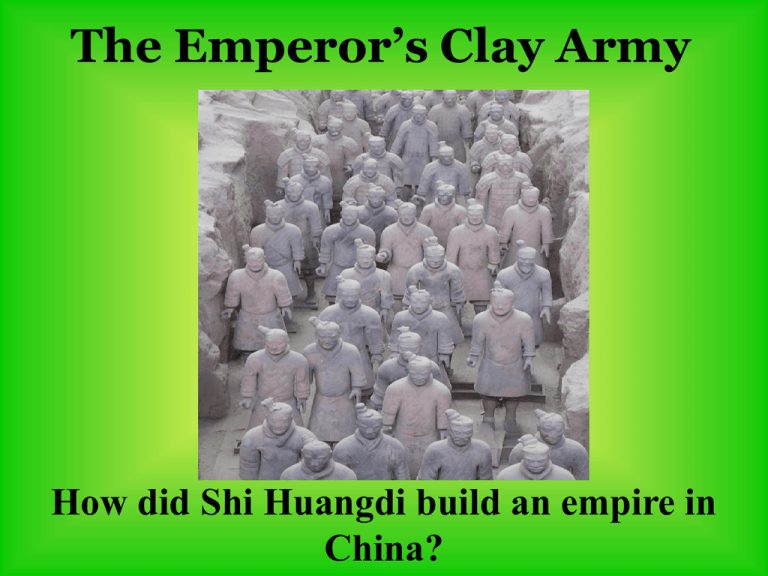
The Emperor’s Clay Army How did Shi Huangdi build an empire in China? In 1974 farmers in the Huang He uncovered life-size clay soldiers while digging a well. An entire clay army- more than 8,000 soldiers, horses, and chariot has been unearthed! No two soldiers looked alike. Each soldier held a real weapon to fight off the enemy. The Qin Dynasty 6.6.5 The Big Idea The Qin dynasty unified China with a strong government and a system of standardization. Main Ideas • The first Qin emperor created a strong but strict government. • A unified China was created through Qin policies and achievements. Shi Huangdi • Yin Zheng took the throne in 221 BC and gave himself the title Shi Huangdi, which means “first emperor.” • Burned books and writings that dealt with any practice other than Legalism. • Strict government/harsh punishments. • Expanded empire to ensure that no more revolts in the new territory. • Claimed all power and took land away from the lords. Commoners were forced to work on government building projects. • China was divided into districts with their own governors. Qin’s most famous ruler was a general who would one day order the making of the clay army. He led an army to take control of the Huang He delta, and won battle after battle, conquering all of northern China. The Qin general declared himself China’s emperor. An emperor is the supreme ruler of an empire. The Qin general took on the name Shi Huangdi,or “First Grand Emperor.” Shi Huangdi boasted that his dynasty would last for 10,000 generations. Geography played a part in the emperor’s victory. The Qin region was protected by the Qinling Mountains on one side and the Huang He River on the other. In addition to strong armies, Shi Huangdi split his empire into provinces, or political divisions of land. To weaken the power of the nobles, Shihuangdi let farmers own land. This forced many nobles to move to the capital city, Xianyang. To further weaken the power of the nobles in Xianyang, Shi Huangdi took away their bronze weapons. Unified China Politics • Shi Huangdi took complete control of the land and the people. • There was a strict chain of command. • Taxes and building projects were introduced. Culture • Shi Huangdi set up a uniform system of law. • Rules and punishment, writing styles, and money were consistent across China. Finance • Gold and copper coins were standardized. • Uniform weights and measures help standardize trade and other legal issues. To unify China, Shi Huangdi set up a single system of writing throughout the empire. Local leaders used this writing to report to the capital, and to record and collect taxes. Shi Huangdi also created a single system of money. Standardized gold and copper coins were used throughout China. Holes in the coins allowed people to keep their money on a string. Qin Achievements Building Projects • Massive government building projects gave jobs to many poor workers. • New roads were built and maintained to provide easy access to and from these buildings. Water Systems • Canals were built to connect rivers and keep trade fast and efficient. • Irrigation systems that are still in use today watered the fields and made more land good for farming. The empire became rich, as taxes from China’s farmers flowed into the capital. But farmers were required to build highways, and walls along the northern border. These walls were built to keep out people of the northern steppes. The Great Wall Of China • Built to protect the country from invasion • Linked previously built walls across China’s northern frontier. • Years of labor from hundreds of thousands of laborers. Much later, similar walls would be built across these same mountains and valleys, making up the Great Wall of China. The Great Wall of China grew to be more than 1,500 miles long. Farmers worked as soldiers and builders, and were the backbone of the empire. Farmers kept the empire strong, but their lives centered around the seasonal floods of the Huang. Farmers continued to grow wheat, rice, and other crops to feed the empire. One of the greatest building projects of the Qin Empire was the construction of a tomb for Shi Huangdi. The emperor wanted his tomb to be a spectacular mirror of the real world. The tomb’s many horses and soldiers stood guard, ready to protect the emperor from attack. Shi Huangdi’s burial place lies under a giant mound near the clay army. Archaeologists have not yet uncovered the contents of the tomb. The tomb contained a map of the empire, models of the Huang He, and bright stars on the ceiling. To keep out robbers, crossbows were set up that would shoot arrows if the tomb was disturbed. The Fall of the Qin: The Oppressed Rise Up • Many scholars, peasants, and nobles grew resentful of Shi Huangdi’s harsh policies and complete control. • Upon the death of Shi Huangdi, the country began to unravel. • Rebel groups fought among themselves, and eventually the Qin capital was burned to the ground. • With no authority present, the country fell into civil war. Shihuangdi’s Empire lasted only 15 years. After his death, farmers and nobles revolted against his harsh rule. However, Shi huangdi left a legacy of systems of writing, money, and government that would last for centuries.

